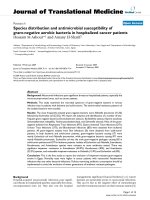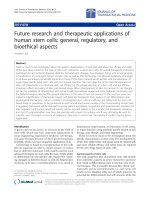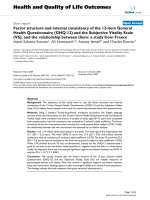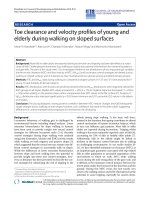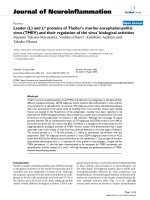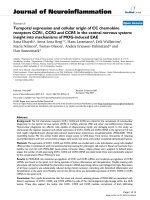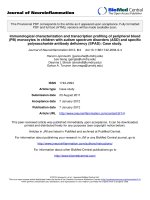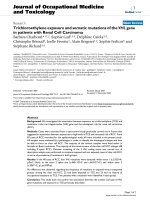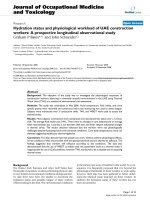báo cáo hóa học: " Immunological characterization and transcription profiling of peripheral blood (PB) monocytes in children with autism spectrum disorders (ASD) and specific polysaccharide antibody deficiency (SPAD): Case study" pot
Bạn đang xem bản rút gọn của tài liệu. Xem và tải ngay bản đầy đủ của tài liệu tại đây (420.06 KB, 34 trang )
This Provisional PDF corresponds to the article as it appeared upon acceptance. Fully formatted
PDF and full text (HTML) versions will be made available soon.
Immunological characterization and transcription profiling of peripheral blood
(PB) monocytes in children with autism spectrum disorders (ASD) and specific
polysaccharide antibody deficiency (SPAD): Case study.
Journal of Neuroinflammation 2012, 9:4 doi:10.1186/1742-2094-9-4
Harumi Jyonouchi ()
Lee Geng ()
Deanna L Streck ()
Gokce A. Toruner ()
ISSN 1742-2094
Article type Case study
Submission date 23 August 2011
Acceptance date 7 January 2012
Publication date 7 January 2012
Article URL />This peer-reviewed article was published immediately upon acceptance. It can be downloaded,
printed and distributed freely for any purposes (see copyright notice below).
Articles in JNI are listed in PubMed and archived at PubMed Central.
For information about publishing your research in JNI or any BioMed Central journal, go to
/>For information about other BioMed Central publications go to
/>Journal of Neuroinflammation
© 2012 Jyonouchi et al. ; licensee BioMed Central Ltd.
This is an open access article distributed under the terms of the Creative Commons Attribution License ( />which permits unrestricted use, distribution, and reproduction in any medium, provided the original work is properly cited.
Immunological characterization and transcription profiling of peripheral blood (PB) monocytes in
children with autism spectrum disorders (ASD) and specific polysaccharide antibody deficiency
(SPAD): Case study.
Harumi Jyonouchi
1,3
, Lee Geng,
1
, Deanna L. Streck
2
, Gokce A. Toruner
2
1
Division of Allergy/Immunology and Infectious Diseases, Department of pediatrics, UMDN-NJMS, 185
South Orange Ave. Newark, NJ 07101-1709, USA
2
The Institute of Genomic Medicine, Department of Pediatrics, UMDNJ-NJMS185 South Orange Ave.
Newark, NJ 07101-1709, USA
E-mail addresses:
Harumi Jyonouchi:
Lee Geng:
Deanna L. Streck:
Gokce A. Toruner:
Corresponding Author: Harumi Jyonouchi, e-mail:
Abstract
Introduction: There exists a small subset of children with autism spectrum disorders (ASD)
characterized by fluctuating behavioral symptoms and cognitive skills following immune insults. Some
of these children also exhibit specific polysaccharide antibody deficiency (SPAD), resulting in frequent
infection caused by encapsulated organisms, and they often require supplemental intravenous
immunoglobulin (IVIG) (ASD/SPAD). This study assessed whether these ASD/SPAD children have distinct
immunological findings in comparison with ASD/non-SPAD or non-ASD/SPAD children.
Case description: We describe 8 ASD/SPAD children with worsening behavioral symptoms/cognitive
skills that are triggered by immune insults. These ASD/SPAD children exhibited delayed type food allergy
(5/8), treatment-resistant seizure disorders (4/8), and chronic gastrointestinal (GI) symptoms (5/8) at
high frequencies. Control subjects included ASD children without SPAD (N=39), normal controls (N=37),
and non-ASD children with SPAD (N=12).
Discussion and Evaluation: We assessed their innate and adaptive immune responses, by measuring the
production of pro-inflammatory and counter-regulatory cytokines by peripheral blood mononuclear
cells (PBMCs) in responses to agonists of toll like receptors (TLR), stimuli of innate immunity, and T cell
stimulants. Transcription profiling of PB monocytes was also assessed. ASD/SPAD PBMCs produced less
proinflammatory cytokines with agonists of TLR7/8 (IL-6, IL-23), TLR2/6 (IL-6), TLR4 (IL-12p40), and
without stimuli (IL-1ß, IL-6, and TNF-α) than normal controls. In addition, cytokine production of
ASD/SPAD PBMCs in response to T cell mitogens (IFN-γ, IL-17, and IL-12p40) and candida antigen (Ag)
(IL-10, IL-12p40) were less than normal controls. ASD/non-SPAD PBMDs revealed similar results as
normal controls, while non-ASD/SPAD PBMCs revealed lower production of IL-6, IL-10 and IL-23 with a
TLR4 agonist. Only common features observed between ASD/SPAD and non-ASD/SPAD children is lower
IL-10 production in the absence of stimuli. Transcription profiling of PB monocytes revealed over a 2-
fold up (830 and 1250) and down (653 and 1235) regulation of genes in ASD/SPAD children, as
compared to normal (N=26) and ASD/non-SPAD (N=29) controls, respectively. Enriched gene expression
of TGFBR (p<0.005), Notch (p<0.01), and EGFR1 (p<0.02) pathways was found in the ASD/SPAD
monocytes as compared to ASD/non-SPAD controls.
Conclusions: The Immunological findings in the ASD/SPAD children who exhibit fluctuating behavioral
symptoms and cognitive skills cannot be solely attributed to SPAD. Instead, these findings may be more
specific for ASD/SPAD children with the above-described clinical characteristics, indicating a possible
role of these immune abnormalities in their neuropsychiatric symptoms.
Keywords: autism spectrum disorders (ASD), cytokine, innate immunity, transcription profiling,
monocytes, specific polysaccharide antibody deficiency (SPAD)
Background
Mounting evidence indicate that ASD is a behaviorally defined syndrome associated with multiple
genetic and environmental factors, resulting in similar behavioral symptoms [1-4]. The exceptions are
small subsets of patients with known gene mutations (up to 15-20%) [5]. Consequently, ASD is
characterized by varying clinical phenotypes and a high frequency of co-morbidities. These co-morbid
conditions often have inflammatory components and inflammation and immune activation has been
implicated in ASD pathogenesis [6-7]. However, previous studies addressing immune abnormalities in
ASD children have been inconclusive, partly due to the marked heterogeneity of the study subjects.
Previously, we reported a subset of ASD children whose clinical symptoms are characterized by
worsening behavioral symptoms and loss of once acquired cognitive skills triggered by benign immune
insults, typically common childhood infection [8]. Among this subset of ASD children, designated as the
ASD-test group in the previous study, we found a high frequency of immunodeficiency (mainly SPAD),
requiring treatment of intravenous immunoglobulin (IVIG) [8]. SPAD is clinically characterized by
impaired antibody production against encapsulated organisms that are common causes of pneumonia,
sinusitis, and ear infection. Therefore, in the previous study, ASD/SPAD children were excluded from the
further analysis, due to the concern that the presence of SPAD and resultant presence of active infection
may affect the results of our immunological assays. Thus, we do not know whether ASD/SPAD children
with fluctuations in behavioral symptoms/cognitive skills have the innate immune abnormalities
observed in the ASD test group [8] or if they manifest immune abnormalities more specific for SPAD.
In the Pediatric Allergy/Immunology (A/I) Clinic at our institution, we follow 8 ASD/SPAD children who
have worsening behavioral symptoms/cognitive skills with immune insults. In these ASD/SPAD children,
even after improved control of infectious complications with IVIG, we still observe worsening behavioral
symptoms/cognitive skills that are triggered by immune insults. These children also seem to have
treatment-resistant seizure disorders at a higher frequency than the ASD/non-SPAD children. In our
observation, there were no differences between ASD/SPAD children and non-ASD children with SPAD
(non-ASD/SPAD) in the routine immune workups. Infectious complications observed in these ASD/SPAD
children in our clinic were very similar to those observed in non-ASD/SPAD children [9]. Innate immune
responses are not routinely studied in conventional immune workups for SPAD. Since our previous
studies have indicated innate immune abnormalities in the ASD test group children [8], we
hypothesized that innate immune responses affecting the development of adaptive cellular and humoral
immunity are altered in the ASD/SPAD children who reveal worsening behavioral symptoms and
cognitive skills with immune insults. We also hypothesized that these altered immune responses are not
attributed to SPAD but are associated with their characteristic neuropsychiatric symptoms as described
above, perhaps reflecting impaired neuroimmune network.
In this study, we tested our hypotheses by further characterizing 8 ASD/SPAD children with fluctuating
behavioral symptoms/cognitive skills, by analyzing their clinical features and immunological findings in
comparison with three control groups: ASD/non-SPAD children, normal control children, and non-
ASD/SPAD children. The obtained results support our initial hypothesis, that peripheral blood
mononuclear cells (PBMCs) from ASD/SPAD children reveal distinct innate and adaptive immune
abnormalities not shared by ASD/non-SPAD or non-ASD/SPAD children.
Case description
ASD/SPAD children:
Eight ASD/SPAD children characterized by fluctuating (worsening) behavioral/cognitive skills following
immune insults including viral infection and adverse reactions to medications were presented in this
study. The demographics, diagnosis, co-morbidities, and clinical laboratory findings of these ASD/SPAD
children are summarized in Tables 1 and 2. These ASD/SPAD children had at least 3 occurrences of
worsening behavioral symptoms and/or loss of once acquired cognitive skills documented following
immune insults such as viral syndrome; viral syndrome (upper respiratory infection and acute
gastroenteritis) was clinically diagnosed with negative streptococcal antigen in throat swab and in some
cases, supported by positive viral antigen and/or DNA in nasal secretions by PCR. Occurrences of
worsening behavioral symptoms were independently documented by caretakers, teachers, and
therapists. SPAD was diagnosed with detectable antibody (Ab) titers (>1.0 µg/ml) to less than 3 of 14
serotypes of Streptococcus pneumonia tested in response to Pneumovax® [10], a standard diagnostic
measure for SPAD. All of the ASD/SPAD children evaluated in this study are currently on IVIG (0.6-1
g/kg/dose every 3 weeks), since their infection complications were not controlled effectively with
prophylactic antibiosis. Assay samples were obtained when their infectious complications were well
under control after implementation of IVIG treatment. The ages of ASD/SPAD children at the time of
sample obtainment were 12.3 yr (median) with range of 8.3-17.5 yr. The length of IVIG treatment varied
from 1 to 6 yrs, at the time blood samples were obtained. It should be noted that we also follow 2
ASD/SPAD children without fluctuation in behavioral symptoms/cognitive skills. They responded very
well to IVIG treatment for controlling infections but we did not observe any changes in their autistic
features. These children were not included in the current study. We refer ASD/SPAD children as these 8
ASD/SPAD children with worsening behavioral symptoms and cognitive skills with immune insults in this
study.
In both ASD/SPAD and ASD/non-SPAD children, autism diagnosis was from established autism
diagnostic centers, including the center at our institution. Standard diagnostic measures, including
ADOS (Autism Diagnostic Observational Schedules), and ADI-R (Autism Diagnostic Interview-Revised)
were used. Diagnosis of allergic disorders and asthma were based on diagnostic criteria described
elsewhere [11-13].
Control subjects:
1. ASD/non-SPAD children: These children were recruited in the Subspecialty Clinic at UMDNJ-NJMS
where subspecialties include allergy/immunology, cardiology, developmental pediatrics,
endocrinology, gastroenterology, genetics, general pediatrics, nephrology, and pulmonology. A
total of 39 ASD/non-SPAD children were recruited to the study: 4 females and 35 males, median
age: 8.1 yr, range; 5-17 yr, 7 African Americans (AA), 3 Asians, 27 Caucasians (W), and 2 mixed races.
These ASD/non-SPAD children were diagnosed with autism (N=25) or PDD-NOS (N=14). Twenty out
of 39 children reported to have developmental regression at the time of initial diagnosis of ASD.
Allergic rhinoconjunctivitis (AR+AC) was diagnosed in 5/39 (12.8%) ASD/non-SPAD children. None of
the control ASD/non-SPAD children were documented to have recurrent infection and/or fluctuating
behavioral symptoms/cognitive skills following immune insults. In addition, none of these ASD/non-
SPAD controls were diagnosed with seizure disorders.
2. Normal controls: Normal control children (N=37, 8 females and 29 males, median age; 10.2 yr,
range: 5-17 yr, 4AA, 1 Asian, 31 W, and 1 mixed race) were recruited in the Pediatric Subspecialty
Clinic. In most cases, blood samples were obtained when they were medically indicated to have
venipuncture for general health screening.
3. Non-ASD/SPAD children: A total of 12 non-ASD/SPAD children were recruited in the pediatric
Allergy/Immunology Clinic; median age; 13.0 yr, range; 6-17 yr, 6 females and 6 males, 4 AA and 8
W. SPAD diagnosis was made as described in ASD/SPAD children in the previous section [10]. All of
them have been treated with IVIG (0.6-1 g/kg/dose every 3 weeks) and were on IVIG treatment at
the time of sample obtainment. The length of IVIG treatment was 1 to 7 yrs for these children at the
time of this study. Two out of 12 patients were diagnosed with seizure disorders; in 1 patient, the
seizure disorder was attributed to sequel of intracranial abscess developed from chronic
rhinosinusitis and in 1 patient, the etiology of seizure disorder is unknown.
Sample obtainment: The study subjects were recruited following study protocols approved by the
Institutional Review Board, University of Medicine and Dentistry of New Jersey-New Jersey Medical
School (UMDNJ-NJMS). Blood samples were collected after obtainment of signed parental consent
forms. Signed assent forms were also obtained, if applicable, in children older than 7 years of age.
At the time of sample obtainment, all the subjects were examined to ensure absence of active
infection. Assays for adaptive and innate immunity for SPAD children, with or without ASD, were
conducted after their conditions were stabilized by IVIG and became free from active infection. In most
cases, sample obtainment coincided with medically indicated blood work.
Clinical and laboratory findings in ASD/SPAD children by conventional immune workup: Most of the
ASD/SPAD children suffered from chronic rhinosinusitis (CRS) and recurrent otitis media (ROM) requiring
frequent antibiosis prior to IVIG treatment. Four out of 8 (50%) ASD/SPAD children had history of
multiple placements of pressure equalizing (PE) tubes bilaterally (Table 1). ASD/SPAD children also
revealed a high frequency of treatment-resistant seizure disorders (4/8, 50%), while none of the normal
and ASD/non-SPAD control children had a history of seizure disorders. However, 25/40 (62.5%)
ASD/non-SPAD children had a history of food protein induced enterocolitis syndrome (FPIES), although
at the time of blood sampling, none of them had active GI symptoms. ASD/SPAD children also had
history of FPIES at a similar rate (5/8, 62.5%) and these ASD/SPAD children with history of FPIES suffered
from chronic enterocolitis, even after IVIG treatment, requiring dietary intervention measures
(avoidance of offending food). In these ASD/SPAD children with GI symptoms, extensive workups ruled
out chronic microbial infection, celiac disease, inflammatory bowel diseases, or other well established GI
diseases by endoscopic and histological examinations. None of the ASD/SPAD subjects revealed positive
allergy workups; they all had normal IgE levels, negative reactivity to prick skin testing (PST), or negative
for food allergen specific IgE. All the ASD/SPAD children were diagnosed with regressive type ASD (Table
1).
As shown in Table 2, immune workups, at initial diagnosis of SPAD, revealed low to low normal serum
levels of IgG, IgA, and IgM as compared to age-appropriate controls in 4/8, 6/8, and 6/8 ASD/SPAD
children. Numbers of isotype-switched memory B cell were lower than 10/µl in 7/8 ASD/SPAD children
[14]. Infection was better controlled after initiation of IVIG treatment in all the ASD/SPAD children,
which was also associated with a reduction in frequency of worsening behavioral symptoms triggered by
infection. After being treated with several doses of IVIG, the parents of one patient reported the return
of cognitive skills that were present prior to major regression. However, 7/8 ASD/SPAD children did not
reveal significant improvement in autism behavioral symptoms or cognitive activity, per parental reports
assessed by the clinical global impression scale (CGI) [15]. In the ASD/SPAD patients with seizure
disorders, frequency of seizures was reduced after starting IVIG treatment, which is likely attributed to
better control of infection, since the major trigger of seizure activity is infection for these subjects.
Further Evaluation of immune functions
1. PBMC Cultures; PBMCs were isolated by Ficoll-Hypaque density gradient centrifugation. Innate
immune responses were assessed by incubating PBMCs (10
6
cells/ml) overnight with TLR4 agonist (LPS;
0.1 µg/ml, GIBCO-BRL, Gaithersburg, MD), TLR2/6 agonist (zymosan; 50 µg/ml, Sigma-Aldrich, St. Luis,
Mo), TLR3 agonist (Poly I:C, Poly I:C, 0.1 µg/ml, Sigma-Aldrich), and TLR7/8 agonist (CL097, water-soluble
derivative of imidazoquinoline, 20 µM, InvivoGen, San Diego, CA) in RPMI 1640 with additives as
previously described [8]. Overnight incubation was adequate to induce the optimal responses in this
setting. Levels of proinflammatory [tumor necrosis factor-α (TNF-α), IL-1β, IL-6, IL-12p40, and IL-23] and
counter-regulatory [IL-10, transforming growth factor-ß (TGF-ß) and soluble TNF receptor II (sTNFRII)]
cytokines in culture supernatant were then measured by an enzyme-linked immunosorbent assay
(ELISA).
Cellular reactivity to T cell stimulants was assessed by incubating PBMCs (10
6
cells/ml) with T cell
mitogens [Con A (2 µg/ml) and PHA (5 µg/ml)], recall Ag [candida Ag (5 µg/ml), Greer, Lenoir, NC], and
IFN-γ inducing cytokines [IL-12p70 (0.2 ng/ml, BD Biosciences, San Diego, CA), IL-18 (1 ng/ml, BD
Biosciences) for 4 days and measuring levels of IFN-γ, TNF-α, IL-5, IL-10, IL-12p40, and IL-17 in the
culture supernatant [8]. Initial titration studies showed that a four-day incubation period resulted in
optimal production of these cytokines, in this setting.
Cytokine levels were measured by ELISA, using OptEIA™ Reagent Sets (BD Biosciences) for IFN-γ, IL-1ß,
IL-5, IL-6, IL-10, IL-12p40, and TNF-α, and ELISA reagent set (R & D, Minneapolis, MN) for sTNFRII, IL-17
(IL-17A), and TGF-ß. IL-23 ELISA kit was purchased from eBiosciences, San Diego, CA. Intra- and inter-
variations of cytokine levels were less than 5%.
2. Flow cytometry; Memory B cells (IgD
-
, CD27
+
, CD19
+
B cells) were detected by staining with anti-CD45-
FITC, anti-CD19-APC-Cy7, CD27-APC (all from BD biosciences, San Jose CA) and IgD-PE (DAKO,
Carpinteria CA) monoclonal antibodies [14]. For intracellular cytokine staining in CD4
+
T cells, the
following fluorochrome-conjugated monoclonal antibodies were used: CD4-PerCp, IFN-γ-PE-Cy7, IL-17-
PE, IL-4-FITC, IL-10-Pacific Blue (all from eBiosicences), and TGF-ß-APC (R & D, Minneapolis, MN). PBMCs
were incubated overnight (16 h) at 37
o
C with medium alone, Staphylococcal enterotoxin B (5 µg/mL,
Sigma-Aldrich), or candida Ag (5 µg/ml, Greer) in the presence of Brefeldin A (BFA; 5 µg/ml, Sigma-
Aldrich), anti-CD28 (1 µg/ml, eBiosciences), and anti-CD49 (1 µg/ml, eBiosciences) in the same culture
medium used for the cytokine production assay. Then PBMCs were permeabilized (permeabilization
buffer, BD Biosciences) and stained with the above described antibodies [16]. All flow cytometry was
conducted using FACS Caliber or FACSVantage SE TM (BD Biosciences) and the data were analyzed with
the CellQuest software (BD Biosciences) and FlowJo (TreeStar, Ashland, OR).
3. Transcription profiling: Peripheral blood (PB) monocytes were purified using an immuno-affinity
column following the manufacturer’s instructions (MACS monocytes isolation kit, Miltenyi Biotec,
Auburn, CA). Total RNA were extracted by the RNA easy kit (Quiagen , Valencia, CA). RNA labeling and
hybridizations
on Agilent Human 4x44K arrays (Agilent, Lexington, MA) were done using
the Agilent One-
Color Microarray-Based Gene Expression Analysis Ver 5.5 protocol (Agilent). All slides were scanned by
an Agilent Scanner and normalized numerical data were obtained by Agilent Feature extraction software
9.5.
4. Statistical analysis: For comparison of test values with control values, a Wilcoxon rank sum test was
used. For comparison of values of multiple groups, a Kruskall-Wallis test was used. A Chi square (χ
2
) test
was used to examine the difference in frequency and correlation was tested using a linear regression
analysis. These tests were performed using R.2.10.1 (R-Development Core Team 2009). A p value of
<0.05 was considered to be statistically significant. For the analysis of microarrays experiments, Gene
Spring GX v11 software (Agilent) was used. After filtering for “present” calls in at least 20% of samples,
fold change analysis were performed for group for comparisons on 26992 probes. Genes with at least a
two-fold change, as compared to controls, are determined to be either up-regulated or down-regulated.
Using a specific module of GeneSpring software (Agilent), pathways enrichment analysis was performed
on those up- or down-regulated genes to see if there is a statistically significant enrichment (p<0.05) for
specific BioPax pathways.
5. Cytokine production results: As stated above, the median ages of the study subjects at the time of
sample obtainment are 12.3 yr for ASD/SPAD children, 8.1 yr for ASD/non-SPAD children, 10.2 yr for
normal controls, and 13.0 yr for non-ASD/SPAD children. Ages of ASD/non-SPAD children were lower
than ASD/SPAD and non-ASD/SPAD children (p<0.05). It should be noted that innate immune
responses, as opposed to adaptive immune responses, are not expected to change with age. This is
mainly because innate immunity is regulated by germ-line coded genes and has little post-natal
modifications, such as gene rearrangement.
Responses to TLR agonists: ASD/SPAD PBMCs produced different patterns of cytokine production.
Namely, ASD/SPAD PBMCs produced lower amounts of IL-6 (without a stimulus and with TLR2/6
agonists), IL-1ß (without a stimulus), and IL-23 (with TLR 7/8 agonist) as compared to all the control
groups (Fig. 1 A, B, C). In, addition, ASD/SPAD PBMCs produced less IL-12p40 than normal and non-
ASD/SPAD control cells in response to a TLR4 agonist (Fig. 1-A). These cells also produced lower
amounts of IL-6 (with the TLR 7/8 agonist) and TNF-α/IL-10 (in the absence of stimulus) than normal
controls (Fig. 1-B). PBMCs from ASD/non-SPAD children revealed similar patterns of cytokine production
as compared to normal controls (Fig. 1). In contrast, non-ASD/SPAD PBMCs revealed altered patterns of
cytokine production which did not resemble those observed in ASD/SPAD children. That is, non-
ASD/SPAD PBMC revealed lower IL-10 production than ASD/SPAD and normal control cells (Fig. 1-A) and
lower IL-6/IL-23 production than normal controls (Fig. 1-C, D) in response to a TLR4 agonist. The only
common feature observed between the ASD/SPAD and non-ASD/SPAD groups was production of lower
levels of IL-10 in the absence of a stimulus, than normal controls (Fig. 1-C). These results indicate that
the altered responses to TLR agonists observed in the ASD/SPAD group are unlikely to be associated
with SPAD.
Responses to the recall antigen and T cell mitogens: ASD/SPAD PBMCs also revealed altered patterns of
T cell cytokine production as compared to control groups. Namely, ASD/SPAD PBMCs produced less IL-
12p40 and IL-10 than all the study groups in response to a recall Ag (candida Ag) (Fig. 2-B). In addition,
ASD/SPAD PBMCs produced less IFN-γ and IL-17A with PHA, and less IL-12 with Con A as compared to
normal controls (Fig. 2-A). Moreover, amounts of IL-17A produced by ASD/SPAD PBMCs with PHA was
also lower than that of non-ASD/SPAD cells (Fig. 2-A). IL-12 production with Con A by ASD/SPAD cells
was also lower than that of ASD/non-SPAD controls (Fig. 2-A). Production of T cell cytokines by
ASD/non-SPAD and non-ASD/SPAD cells did not differ from normal controls in response to T cell
mitogens or candida Ag (Fig. 2-A & B). TGF-ß is produced in high amounts spontaneously and does not
increase much in response to T cell stimuli. However, interestingly, we observed a higher increase in
TGF-ß production in response to candida Ag in the ASD/SPAD group than normal and non-ASD/SPAD
groups. Again, these results indicate that altered patterns of T cell cytokine production by the
ASD/SPAD PBMCs is unlikely to be attributed to SPAD.
When intracellular expression of Th1 (IFN-γ), Th2 (IL-4), Th17 (IL-17A), and regulatory cytokines (IL-10
and TGF-ß) were examined in 6/8 ASD/SPAD children, we observed lower intracellular expression of
TGF-β in CD4
+
cells, as compared to age-appropriate controls (ASD/non-SPAD children N=18, normal
controls N=26, and non-ASD/SPAD children N=9) (Fig. 3).
6. Transcription profiling of PB monocytes: Since most notable changes were found in TLR responses in
ASD/SPAD children and these changes were not observed in non-ASD/SPAD controls, we conducted
transcription profiling of PB monocytes, a major cell population of PB innate immune cells responding to
TLR agonists. Transcription profiling was conducted in 7 ASD/SPAD, 28 ASD/non-SPAD, and 26 normal
control children. We were unsuccessful in 2 our attempts to purify total RNA from PB monocytes of 1
ASD/SPAD child; this may be associated with the high dose of valproic acid that he was on in order to
control his seizure activities. Our results revealed that significant numbers of genes were either up or
down-regulated (>2 fold) in ASD/SPAD monocytes as compared to controls, as summarized in Table 3.
Up-regulated genes as compared to control groups included chemokines (CCL2 and CCL7). Pathway
analysis of gene expression profiles revealed that ASD/SPAD children had enriched expression of genes
involved in TGFBR (TGF-ß receptor), EGFR (epidermal growth factor receptor), and NOTCH pathways as
compared to ASD/non-SPAD controls (Table 3).
Discussion and Evaluation
Clinical features of infection found in ASD/SPAD children are similar to those found in non-ASD/SPAD
children and all of the ASD/SPAD children suffered from frequent sino-pulmonary infection (Table 2)
[17]. As expected, infections were better controlled, once IVIG treatment was in place [18-19].
However, the ASD/SPAD children revealed a higher frequency of seizure disorders as compared to non-
ASD/SPAD children (4/8, 50% vs. 2/12 16.7%). In 2/4 ASD/SPAD children with seizure disorders, seizure
activity was often associated with infection and is better controlled after implementation of IVIG
treatment (Table 1). No subjects in the normal control and ASD/non-SPAD groups suffered from seizure
disorders. As noted previously, these ASD/SPAD subjects are those with markedly worsening behavioral
symptoms/cognitive skills following each immune insult [8]. These results raise the question of whether
the immune abnormalities that are associated with SPAD, contribute to the clinical features observed in
the ASD/SPAD children. Alternatively, it may be possible that SPAD is a part of the clinical features that
develop with age in the ASD/SPAD children and are associated with immune abnormalities that affect
Ab production and possibly the neuroimmune network. Interestingly, in 3/4 ASD/SPAD subjects with
seizure disorders, SPAD was diagnosed several years later after the diagnosis of seizure disorders.
Routine immune workups of ASD/SPAD children did not reveal major defects of T or B cells, except for
those indicating impaired antibody production typically found in SPAD patients (Table 2). Infectious
complications in the ASD/SPAD children were very similar to those observed in non-ASD/SAPD children
[9]. Therefore, pathogen-specific mechanisms are unlikely to explain neuropsychiatric symptoms of
fluctuating behavioral symptoms/cognitive skills in the ASD/SPAD children examined in this study.
When innate immune responses were assessed, by measuring responses to a panel of TLR agonists, we
observed significant differences in the ASD/SPAD children, as compared to control groups. That is,
PBMCs from the ASD/SPAD children tended to produce less pro-inflammatory cytokines (TNF-α, IL-1ß,
IL-6, IL-12, and IL-23). Changes were most evident in the production of IL-6. As for production of
counter-regulatory cytokines, PBMCs from ASD/SPAD children revealed less spontaneous IL-10
production than normal controls. Responses to TLR agonists in the non-ASD/SPAD children differed
significantly from those observed in the ASD/SPAD children as detailed in the results section and Fig. 1.
Only common feature found in both the ASD/SPAD and non-ASD/SPAD children was lower spontaneous
production of IL-10 than normal controls (Fig. 1-C).
Since ASD/SPAD children are on multiple medications for asthma, chronic rhinitis, and infection
prophylaxis which included montelukast, steroid oral/nasal inhalers, anti-histamines, and azithromycin
prophylaxis, these finding could be attributed to medications that they were on. However, non-
ASD/SPAD children were also on multiple medications similar to those taken by ASD/SPAD children.
Therefore it is unlikely that these medications are affecting the assay results. Some ASD/SPAD children
were also on anti-seizure medications including levetiracetam (N=2), valproic acid (N=1), and lorazepam
(N=1). However, it is hard to assess if these medications can affect the assay results given low frequency
of intake of these medications among the ASD/SPAD children. Two ASD/non-SPAD children with seizure
disorders were also on levetiracetam and valproic acid.
IL-6 is important for B cell maturation and Ab production [16]. Our finding of impaired IL-6 production
in ASD/SPAD children might be associated with development of SPAD in the ASD/SPAD children.
Decreased production of IL-10 may also indicate a possibility of prolonged inflammation in ASD/SPAD
children. Proinflammatory cytokines especially TNF-α, IL-1ß, and IL-6 exert important roles in mediating
acute stress responses and dysregulated production of these cytokines were implicated with chronic
CNS inflammation [20-21], as well as, schizophrenia [22]. Thus, lower production of these key cytokines
may indicate an impairment of stress responses or the neuro-immune network in the ASD/SPAD
children with fluctuating behavioral symptoms/cognitive skills.
Cytokines produced by innate immune responses greatly affect differentiation of T-helper (Th) cell
subsets. IL-1ß, IL-6, and TGF-ß, when combined together, promote differentiation of Th17 cells, which in
turn promote neutrophilic inflammation and anti-fungal/bacterial defense [23-25]. IL-23 sustains Th17
cells [23-25]. IL-12 promotes differentiation of Th1 cells [26]. Given decreased IL-12, IL-6, and IL-1ß
production in the ASD/SPAD children, the question is raised as to whether production of T cell cytokines
specific for Th cell subsets is altered in ASD/SPAD children. When we tested T cell cytokine production,
our results revealed lower production of IFN-γ, Th1 cytokine, and IL-17A, Th17 cytokine, in response to
PHA in the ASD/SPAD children (Fig. 2-A). These results indicate a possible impairment of Th1 and
perhaps Th17 responses in the ASD/SPAD children, making them more vulnerable to certain microbial
infection. However, frequency of Th1 and Th17 subsets identified by intracellular cytokine expression
were not altered in ASD/SPAD children. The non-ASD/SPAD children did not reveal such changes.
Further studies regarding Th1/Th17 cell development will be required in the ASD/SPAD children with
fluctuating behavioral symptoms and cognitive skills.
When we tested adaptive immune responses to recall Ags, we observed significantly less production of
IL-10 and IL-12p40 with candida Ag, but higher increase of TGF-ß production in the ASD/SPAD children,
than control groups. IFN-γ or IL-17A production with candida Ag did not differ among the study groups.
Interestingly, 5 of 8 ASD/SPAD children had chronic GI inflammation often complicated by dysbiosis
and/or candida enteritis with evidence of positive reactivity to candida antigen when assessed by
production of IFN-γ and IL-17A production at the time of flare up. These children frequently required
treatments with oral anti-fungal medications. Both IL-10 and IL-12p40 can function as regulatory factors
to control inflammatory responses. Thus a decreased production of these cytokines with candida Ag
may lead to persistent and excessive immune responses against candida Ag in the ASD/SPAD children.
Intracellular expression of TGF-β was lower in the ASD/SPAD children than controls (Fig. 7) when
stimulated with SEB or candida Ag. These findings indicate decreased frequency of TGF-β
+
inducible
regulatory T (Treg) cells in the ASD/SPAD children, despite higher increase in TGF-ß production by
ASD/SPAD PBMCs than controls. TGF-ß is produced by many lineage cells and the source of TGF-ß in the
cultures of ASD/SPAD PBMCs may not be Treg cells, but other lineage cells. Such changes were not
observed in non-ASD/SPAD children. In summary, studies of T cell functions indicate dysregulated T cell
functions in the ASD/SPAD children, but not in the non-ASD/SPAD children. These findings may be
associated with altered innate immune responses in the ASD/SPAD children.
Circulating monocytes in the PB have a short half-life and undergo spontaneous apoptosis on a daily
basis [27]. In response to various differentiation factors, monocytes escape their apoptotic fate by
differentiating into macrophages [27-28], which usually happens during inflammatory responses. PB
monocytes are heterogeneous consisting of M1 monocytes (CD14++, CD16- cells) and M2 monocytes
(CD14+, CD16+ cells) [27, 29]. The majority of PB monocytes is M1 monocytes and activated M1
monocytes are recruited to the site of inflammation via chemokines (CCL2 and CCL7) [27, 29]. To further
extend our investigations, we conducted transcription profiling of PB monocytes in ASD/SPAD children
in comparison with ASD/non-SPAD and normal controls. Over 300 genes are either up- or down-
regulated in the ASD/SPAD children, in comparison with both ASD/non-SPAD and normal control groups
(Table 3). Interestingly, gene expression of CCL2 and CCL7 was up-regulated in PB monocytes from the
ASD/SPAD children. Recruitment of M1 monocytes has been implicated with chronic inflammatory
conditions, including those in the CNS [27, 30]. Thus, up-regulated expression of CCL2 and CCL7 may
indicate a constant activation signal occurring in PB monocytes in the ASD/SPAD children.
The results of transcription profiling of PB monocytes also revealed enriched expression of genes in
TGFBR (TGF-β receptor), NOTCH, and EGFR (epidermal growth factor receptor) signaling pathways in
ASD/SPAD children, as compared to ASD/non-SPAD controls. Pathogen associated molecular patterns
(PAMPs) often up-regulate NOTCH ligands and NOTCH signaling in macrophage/monocyte lineage cells
[31], which can, in turn, affect production of cytokines regulating Th cell subsets [32]. NOTCH signaling
is also known to affect the activation status of microglial cells and neural progenitor cells [33-35].
NOTCH and EGFR pathways are closely inter-related and involved in regulation of cell differentiation and
proliferation [36-37]. TGFBR pathway activation is implicated with cell proliferation and wound healing
along with its anti-inflammatory properties of TGF-ß [38]. In addition, TGF-ß pathways closely interact
with NOTCH and EGFR signaling pathways [31]. Thus the findings from the transcription profiling of PB
monocytes also support our assumption that ASD/SPAD monocytes are chronically activated which may
be associated with the fluctuating neuropsychiatric symptoms observed in the ASD/SPAD children.
Further analysis of a larger number of these children in comparison with appropriate controls will be
necessary for further elucidate whether PB monocytes play a role in the medical conditions of ASD/SPAD
children. In addition, follow-up of these parameters in the ASD/SPAD children longitudinally will be
informative to further address their immune abnormalities in association with their above-described
clinical features.
Use of IVIG for treatment of autism or its ‘presumed’ autoimmune co-morbid conditions, such as
pediatric autoimmune neuropsychiatric disorders associated with streptococci (PANDAS), has been
controversial, and clinical trials yielded conflicting results [39-41]. The controversy surrounding the
effects of IVIG on ASD children is partly attributed to marked heterogeneity of ASD subjects and
relatively small numbers of study subjects. In our cohorts, beneficial effects of IVIG on cognitive
skills/behavioral symptoms were observed in only one of 8 ASD/SPAD subjects, indicating the complexity
of ASD pathogenesis and the need for careful evaluation of the use of IVIG in ASD children, other than
for antibody deficiency syndrome.
The limitation of this study is the lack of transcription profiling data in PB monocytes from the non-
ASD/SPAD children, due to both limited resources and restrictions associated with the study protocol.
However, to our knowledge, we have not found any literature describing similar changes in transcript
profiles of PB monocytes in non-ASD/SPAD children. At least two ASD/SPAD children without
fluctuation of behavioral symptoms/cognitive skills are followed in our clinic. In these children, we have
not observed the immune abnormalities found in ASD/SPAD children described in this case series
(unpublished observation). These results again indicate that the immune abnormalities observed in
ASD/SPAD children with fluctuating behavioral symptoms/cognitive skills are not solely attributed to
SPAD.
Conclusions
In summary, our results revealed distinct clinical and immunological findings in ASD/SPAD children who
reveal worsening behavioral symptoms/cognitive skills with immune insults. These immune
abnormalities are not shared by either ASD/non-SPAD or non-ASD/SPAD children. Thus these
abnormalities are likely to be more specific for this subset of ASD children and may be associated with
their worsening behavioral symptoms/cognitive skills with immune insults. Development of SPAD in
these ASD children may also be a part of their clinical spectrum associated with these immune
abnormalities.
Abbreviations:
Abbreviations used are as follows: AA, African American, Ab, antibody, Ag, antigen, ASD, autism
spectrum disorders COM, chronic otitis media CRS, chronic rhinosinusitis, CVID, common variable
immunodeficiency, FA, food allergy, FPIES, food protein induced enterocolitis syndrome, IVIG, intravenous
immunoglobulin, IL, interleukin, PB, peripheral blood, PBMCs, peripheral blood mononuclear cells, PDD-
NOS, pervasive developmental disorder, not otherwise specified, PE tube, pressure equalizing tube, SEB,
staphylococcal enterotoxin B, SPAD, specific polysaccharide antibody deficiency, sTNFRII, soluble TNF
receptor II, Th, T-helper, TGF, transforming growth factor, TNF, tumor necrosis factor.
Competing Interests
There are no competing interests to report by any of the authors.
Authors’ contributions
HJ was responsible for the study design, recruitment of the study subject, collection of clinical
information and blood samples, and analysis of the data of cytokine production assays and flow
cytometry. She was also mostly responsible for preparation of this manuscript. LG conducted most of
cytokine production assays as well as staining cells for flow cytometry and assisted the first author for
data analysis. She was also responsible for PB monocytes purification and preparation of total RNA from
PB monocytes. DLS was mostly responsible for conducting transcription profiling of PB monocytes.
GAT was responsible for experimental design of transcription profiling and analysis of the data of
transcription profiling as well as manuscript preparation associated with transcription profiling. All the
authors read and approved the final manuscript.
Author’s information
Harumi Jyonouchi, M.D.: She is a board certified in Pediatrics and Allergy/Immunology and currently
serves as an Associate Professor of Pediatrics, UMDNJ-NJMS. She has conducted several clinical studies
addressing relationship of delayed type food allergy (FA) with GI symptoms in ASD children as well as
immune abnormalities in a subset of ASD children with distinct clinical characteristics.
Gokce A. Truner, M.D., Ph.D.: He is a molecular geneticist and currently is an Assistant Professor at the
Institute of Genomic Medicine, UMDNJ-NJMS. He has been involved in clinical studies of CGH,
transcription profiling, and microRNA profiling in patients with various medical conditions including
children with mental retardation and ASD.
Acknowledgements
The authors thank all the study subjects and parents for donating blood samples. This study was partly supported
by a grant from Jonty Foundation, St. Paul, MN and Autism Research Institute, San Diego, CA. Authors are also
thankful for Dr. L. Huguienin for critically reviewing this manuscript.
References
1. Bale TL, Baram TZ, Brown AS, Goldstein JM, Insel TR, McCarthy MM, Nemeroff CB, Reyes TM,
Simerly RB, Susser ES, Nestler EJ: Early life programming and neurodevelopmental disorders.
Biol Psychiatry 2010, 68:314-319.
2. Rudan I: New technologies provide insights into genetic basis of psychiatric disorders and
explain their co-morbidity. Psychiatr Danub 2010, 22:190-192.
3. Toro R, Konyukh M, Delorme R, Leblond C, Chaste P, Fauchereau F, Coleman M, Leboyer M,
Gillberg C, Bourgeron T: Key role for gene dosage and synaptic homeostasis in autism spectrum
disorders. Trends Genet 2010, 26:363-372.
4. Betancur C: Etiological heterogeneity in autism spectrum disorders: more than 100 genetic and
genomic disorders and still counting. Brain Res 2011, 1380:42-77.
5. Weiss LA: Autism genetics: emerging data from genome-wide copy-number and single
nucleotide polymorphism scans. Expert Rev Mol Diagn 2009, 9:795-803.
6. Ashwood P, Wills S, Van de Water J: The immune response in autism: a new frontier for autism
research. J Leukoc Biol 2006, 80:1-15.
7. Singh VK: Phenotypic expression of autoimmune autistic disorder (AAD): a major subset of
autism. Ann Clin Psychiatry 2009, 21:148-161.
8. Jyonouchi H, Geng L, Cushing-Ruby A, Quraishi H: Impact of innate immunity in a subset of
children with autism spectrum disorders: a case control study. J Neuroinflammation 2008,
5:52.
9. Notarangelo LD, Fischer A, Geha RS, Casanova JL, Chapel H, Conley ME, Cunningham-Rundles C,
Etzioni A, Hammartrom L, Nonoyama S, et al: Primary immunodeficiencies: 2009 update. J
Allergy Clin Immunol 2009, 124:1161-1178.
10. Paris K, Sorensen RU: Assessment and clinical interpretation of polysaccharide antibody
responses. Ann Allergy Asthma Immunol 2007, 99:462-464.
11. Butrus S, Portela R: Ocular allergy: diagnosis and treatment. Ophthalmol Clin North Am 2005,
18:485-492, v.
12. Nassef M, Shapiro G, Casale TB: Identifying and managing rhinitis and its subtypes: allergic and
nonallergic components a consensus report and materials from the Respiratory and Allergic
Disease Foundation. Curr Med Res Opin 2006, 22:2541-2548.
13. Expert Panel Report 3 (EPR-3): Guidelines for the Diagnosis and Management of Asthma-
Summary Report 2007. J Allergy Clin Immunol 2007, 120:S94-138.
14. Alachkar H, Taubenheim N, Haeney MR, Durandy A, Arkwright PD: Memory switched B cell
percentage and not serum immunoglobulin concentration is associated with clinical
complications in children and adults with specific antibody deficiency and common variable
immunodeficiency. Clin Immunol 2006, 120:310-318.
15. Shea S, Turgay A, Carroll A, Schulz M, Orlik H, Smith I, Dunbar F: Risperidone in the treatment of
disruptive behavioral symptoms in children with autistic and other pervasive developmental
disorders. Pediatrics 2004, 114:e634-641.
16. Tangye SG, Cook MC, Fulcher DA: Insights into the role of STAT3 in human lymphocyte
differentiation as revealed by the hyper-IgE syndrome. J Immunol 2009, 182:21-28.
17. Kainulainen L, Vuorinen T, Rantakokko-Jalava K, Osterback R, Ruuskanen O: Recurrent and
persistent respiratory tract viral infections in patients with primary hypogammaglobulinemia.
J Allergy Clin Immunol 2010, 126:120-126.
18. Lucas M, Lee M, Lortan J, Lopez-Granados E, Misbah S, Chapel H: Infection outcomes in patients
with common variable immunodeficiency disorders: relationship to immunoglobulin therapy
over 22 years. J Allergy Clin Immunol 2010, 125:1354-1360 e1354.
19. Orange JS, Grossman WJ, Navickis RJ, Wilkes MM: Impact of trough IgG on pneumonia
incidence in primary immunodeficiency: A meta-analysis of clinical studies. Clin Immunol 2010,
137:21-30.
20. Elenkov IJ: Neurohormonal-cytokine interactions: implications for inflammation, common
human diseases and well-being. Neurochem Int 2008, 52:40-51.
21. Rivest S: Interactions between the immune and neuroendocrine systems. Prog Brain Res 2010,
181:43-53.
22. Watanabe Y, Someya T, Nawa H: Cytokine hypothesis of schizophrenia pathogenesis: evidence
from human studies and animal models. Psychiatry Clin Neurosci 2010, 64:217-230.
23. Conti HR, Gaffen SL: Host responses to Candida albicans: Th17 cells and mucosal candidiasis.
Microbes Infect 2010, 12:518-527.
24. Kimura A, Kishimoto T: Th17 cells in inflammation. Int Immunopharmacol 2011, 11:319-322.
25. McGeachy MJ, Cua DJ: Th17 cell differentiation: the long and winding road. Immunity 2008,
28:445-453.
26. Bousfiha A, Picard C, Boisson-Dupuis S, Zhang SY, Bustamante J, Puel A, Jouanguy E, Ailal F, El-
Baghdadi J, Abel L, Casanova JL: Primary immunodeficiencies of protective immunity to
primary infections. Clin Immunol 2010, 135:204-209.
27. Parihar A, Eubank TD, Doseff AI: Monocytes and macrophages regulate immunity through
dynamic networks of survival and cell death. J Innate Immun 2010, 2:204-215.
28. Wiktor-Jedrzejczak W, Gordon S: Cytokine regulation of the macrophage (M phi) system
studied using the colony stimulating factor-1-deficient op/op mouse. Physiol Rev 1996, 76:927-
947.
29. Serbina NV, Jia T, Hohl TM, Pamer EG: Monocyte-mediated defense against microbial
pathogens. Annu Rev Immunol 2008, 26:421-452.
30. Biswas SK, Mantovani A: Macrophage plasticity and interaction with lymphocyte subsets:
cancer as a paradigm. Nat Immunol 2010, 11:889-896.
31. Jurynczyk M, Selmaj K: Notch: a new player in MS mechanisms. J Neuroimmunol 2010, 218:3-
11.
32. Hu X, Chung AY, Wu I, Foldi J, Chen J, Ji JD, Tateya T, Kang YJ, Han J, Gessler M, et al: Integrated
regulation of Toll-like receptor responses by Notch and interferon-gamma pathways.
Immunity 2008, 29:691-703.
33. Cao Q, Lu J, Kaur C, Sivakumar V, Li F, Cheah PS, Dheen ST, Ling EA: Expression of Notch-1
receptor and its ligands Jagged-1 and Delta-1 in amoeboid microglia in postnatal rat brain and
murine BV-2 cells. Glia 2008, 56:1224-1237.
34. Grandbarbe L, Michelucci A, Heurtaux T, Hemmer K, Morga E, Heuschling P: Notch signaling
modulates the activation of microglial cells. Glia 2007, 55:1519-1530.
35. Teachey DT, Seif AE, Brown VI, Bruno M, Bunte RM, Chang YJ, Choi JK, Fish JD, Hall J, Reid GS, et
al: Targeting Notch signaling in autoimmune and lymphoproliferative disease. Blood 2008,
111:705-714.
36. Aguirre A, Rubio ME, Gallo V: Notch and EGFR pathway interaction regulates neural stem cell
number and self-renewal. Nature 2010, 467:323-327.
37. Berasain C, Perugorria MJ, Latasa MU, Castillo J, Goni S, Santamaria M, Prieto J, Avila MA: The
epidermal growth factor receptor: a link between inflammation and liver cancer. Exp Biol Med
(Maywood) 2009, 234:713-725.
38. Sanjabi S, Zenewicz LA, Kamanaka M, Flavell RA: Anti-inflammatory and pro-inflammatory roles
of TGF-beta, IL-10, and IL-22 in immunity and autoimmunity. Curr Opin Pharmacol 2009, 9:447-
453.
39. DelGiudice-Asch G, Simon L, Schmeidler J, Cunningham-Rundles C, Hollander E: Brief report: a
pilot open clinical trial of intravenous immunoglobulin in childhood autism. J Autism Dev
Disord 1999, 29:157-160.
40. Gupta S, Samra D, Agrawal S: Adaptive and Innate Immune Responses in Autism: Rationale for
Therapeutic Use of Intravenous Immunoglobulin. J Clin Immunol 2010, Apr 15 [Epub ahead of
print] PMID: 20393790.
